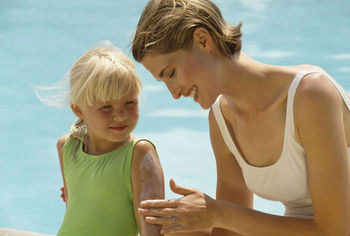Safe Tanning – Is it Possible?
There is no such thing as a good tan. A tan is a sign of ultraviolet damage to your skin. Continued sun exposure and tanning not only damages your skin, making you look older than your chronological age, but it also significantly increases your chances of developing skin cancers.
The best advice is to use sunscreen with an SPF of 30 in adequate amounts before you are exposed to the sun. You should apply at least a shot glass full of sunscreen to your entire body prior to going out into the sun and reapply the sunscreen at least every 2-3 hours or more often if you’ve been sweating. Since sunlight is made up of UVA and UVB rays, make sure to use sunscreen that protects against both types of rays. Using tanning oil instead of applying sunscreen when you are participating in outdoor activities is a huge mistake since oil provides absolutely no sun protection.
Pay special attention to your feet and ankles. These areas are especially susceptible because sunscreen can easily be accidentally rubbed or washed off. Additionally, use a lip balm that contains sun block with an SPF of 30 in it and try not to lick your lips too often.
Many people have a reaction to the products in sunscreens themselves. You many need to test different products made especially for sensitive skin that don’t contain extraneous chemicals to find the one that works the best on you. Some to try may be Blue Lizard Australian Sunscream or Neutrogena Sensitive Skin Sunblock. The sunscreens made for children may also give you a better result than those for adults.
Wearing protective clothing and a hat also will help. Remember that sunlight can pass through loose-weave light colored clothing so wear densely woven, dark colored clothing. You can also buy clothing with added UV protection, or you can add UV protection to existing clothing by washing it with a rinse made by RIT (Rit Sun Guard Laundry Treatment UV Protectant).
Even one blistering sunburn can significantly increase your chances of developing skin cancer. Your sensitivity to the sun, what time of day you are out in the sun, and how close to the equator you are all determine how quickly your skin will burn. If you do develop a severe sunburn, usually time, 48-96 hours, will resolve all the symptoms. Keep the skin comfortable by applying cold compresses or taking cool baths. To prevent possible infection, do not pop the blisters; instead, let them naturally disappear. The time this will take depends on how severe a sunburn you have. If you have no other health issues, over-the-counter anti-inflammatory medications such as Advil or Tylenol will help relieve some of the pain. If you see any signs of infection, run a fever, or if the blisters are not healing after 4-5 days, you may want to seek a medical opinion.
A really bad sunburn is not sun poisoning, just too much sun exposure. True sun poisoning is called Solar Urticaria. It is a rare reaction to sun exposure and is a true sun allergy. It develops rapidly — moments after exposure — the skin begins to itch, and then becomes red with wheals (red patches) or vesicles (bumps). If you truly have sun poisoning, then any exposure to sun will cause a reaction, including a tanning bed. The actual mechanism that causes this reaction is unknown; however, antihistamines, such as Benadryl, are effective in treating the reactions of some patients and will relieve some of the itching. Check with your doctor before taking any medication.
For more information:
Go to the Injury Prevention and Safety health topic.
